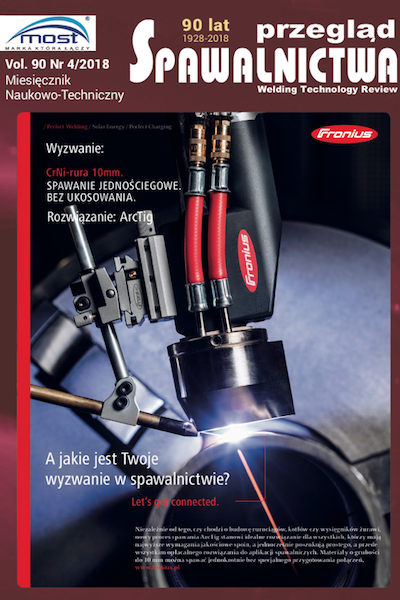The effect of long-term thermal treatment on fatigue life of bimetal zirconium-steel
Main Article Content
Abstract
The paper describes the structure, mechanical properties and fatigue cracks growth in explosively welded zirconium carbon steel cladding system subjected to long-lasting temperature impact. After annealing at 600 °C for 10 and 100 hours the samples were subjected to microscopic observations and finally the microhardness, tensile strength and cyclic bending were determined. In the deformed specimens the initiation of fatigue cracks occurred in the steel whereas further cracks growth occurred parallel to the applied load.
in polish
Wpływ długotrwałej obróbki cieplnej na trwałość zmęczeniową bimetalu cyrkon-stal
W pracy opisano strukturę, właściwości mechaniczne oraz rozwój pęknięć zmęczeniowych w układach platerów cyrkon-stal zgrzewanych wybuchowo, poddanych długotrwałemu oddziaływaniu temperatury. Próbki w stanie po spojeniu wygrzewano w temperaturze 600 °C w czasie 10 i 100 godzin, a następnie poddano obserwacjom mikroskopowym, określono twardość, wytrzymałość na rozciąganie oraz poddano wahadłowemu zginaniu. W odkształconych próbkach zaobserwowano wzrost pęknięć zmęczeniowych równolegle do przyłożonego obciążenia, przy czym inicjacja pęknięć występowała w stali.
Downloads
Article Details
Creative Commons CC BY 4.0 https://creativecommons.org/licenses/by/4.0/
Welding Technology Review (WTR) articles are published open access under a CC BY licence (Creative Commons Attribution 4.0 International licence). The CC BY licence is the most open licence available and considered the industry 'gold standard' for open access; it is also preferred by many funders. This licence allows readers to copy and redistribute the material in any medium or format, and to alter, transform, or build upon the material, including for commercial use, providing the original author is credited.
References
Walczak W.: Zgrzewanie wybuchowe metali i jego zastosowanie, WNT, Warszawa 1989.
Prażmowski M.: Mechanical properties of zirconium/steel bimetal fabricated by means of explosive welding at varied detonation velocities, Archives of Metallurgy and Materials, vol. 59, pp.1137-1142, 2014.
Prażmowski M., Paul H.: The effect of stand-off distance on the structure and properties of zirconium-carbon steel bimetal produced by explosion welding, Archives of Metallurgy and Materials, vol. 57, pp. 1201-1210, 2012.
Paul H., Faryna M., Prażmowski M., Bański R.: Changes In the bonding zone of explosively welded sheets. Archives of Metallurgy and Materials, vol. 56, pp. 1201-1210, 2011.
Prażmowski M., Rozumek D., Paul H.: Static and fatigue tests of bimetal Zr-steel made by explosive welding, Engineering Failure Analysis vol. 75, pp. 71-81, 2017.
Prażmowski M., Paul H., Żok F.: The effect of heat treatment on the properties of zirconium-carbon steel bimetal produced by explosion welding, Archives of Metallurgy and Materials, vol. 59, pp.1143-1149, 2014.
Bański R., Paul H., Prażmowski M., Miszczyk M.: Wpływ obróbki cieplnej na zmiany strukturalne oraz własności mechaniczne bimetali Ti/Ni wytwarzanych metodą spajania wybuchowego, Rudy i metale nieżelazne, R 57, nr 5, s. 312-318, 2012.
Prażmowski M., Paul H.: Charakterystyka bimetali cyrkon-stal wykonanych technologią zgrzewania wybuchowego przy zastosowaniu zróżnicowanych parametrów procesu, Przegląd Spawalnictwa, vol. 4, s. 15-21, 2012.
